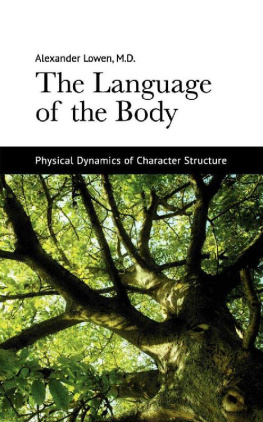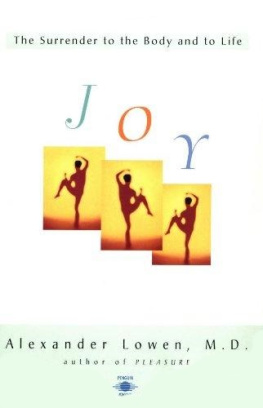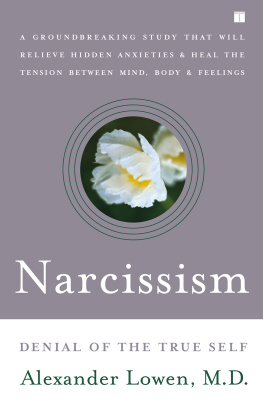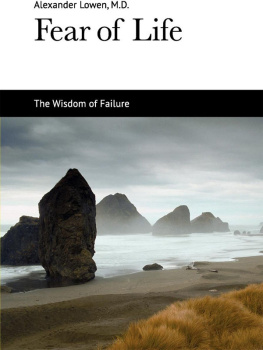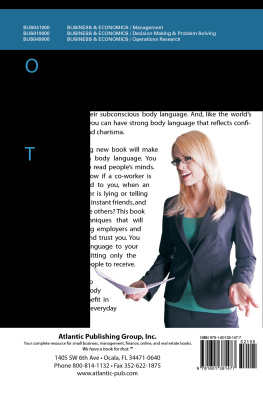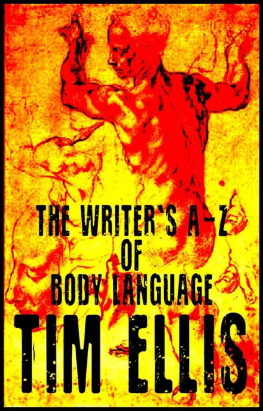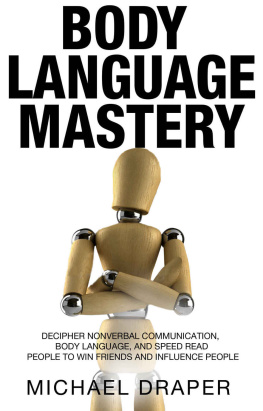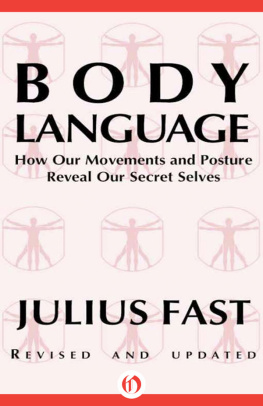The Language of the Body:
Physical Dynamics of Character Structure
Books by Alexander Lowen, M.D.
The Language of the Body (1958)
Originally published as Physical Dynamics of Character Structure
Love and Orgasm: A Revolutionary Guide to Sexual Fulfillment (1965)
The Betrayal of the Body (1967)
Pleasure: A Creative Approach to Life (1970)
Bioenergetics: The Revolutionary Therapy That Uses the Language of the Body to Heal the Problems of the Mind (1976)
Depression and the Body: The Biological Basis of Faith and Reality (1977)
The Way to Vibrant Health: A Manual of Bioenergetic Exercises, co-author Leslie Lowen (1977)
Fear of Life (1980)
Narcissism: Denial of the True Self (1984)
Love, Sex, and Your Heart (1988)
The Spirituality of the Body: Bioenergetics for Grace and Harmony (1990)
Joy: The Surrender to the Body and to Life (1995)
Honoring the Body: The Autobiography of Alexander Lowen, M.D. (2004)
The Voice of the Body: Selected Public Lectures 1962-1982 (2005)
The Language of the Body
Alexander Lowen, M.D.
The Alexander Lowen Foundation
www.lowenfoundation.org
The Language of the Body
Published by The Alexander Lowen Foundation
1852 Texas Hill Rd.,
Hinesburg, VT 05461 USA
Phone: 802-338-2866
www.lowenfoundation.org
Copyright 1958 by Alexander Lowen, M.D.
All rights reserved. No part of this book may be reproduced or transmitted in any form or by any means, electronic or mechanical, including photo-copying, recording or by any information storage and retrieval system, without permission in writing from the Publisher.
Except in the United States of America, this book is sold subject to the condition that it shall not, by way of trade or otherwise, be lent, re-sold, hired out, or otherwise circulated without the publishers prior consent in any form of binding or cover other than that in which it is published and without a similar condition including this condition being imposed on the subsequent publisher.
Library of Congress Control Number 2006937862
ISBN 978-1-938485-16-9 (paperback)
ISBN 978-1-938485-17-6 (ebook)
First Edition by The Alexander Lowen Foundation, 2012
Printed in the United States of America
To Leslie, my wife,
who has been a never failing
inspiration to me
Contents
Introduction
It has been nearly 50 years since Alexander Lowen published his first book, the Physical Dynamics of Character Structure, which later was released under the title The Language of the Body. This edition combines both titles. In this seminal work, Lowen outlined the basic tenets of bioenergetic analysis, including a discussion of characterology from a bioenergetic perspective. His subsequent works have expanded on the themes first introduced in this book but, unlike many authors who significantly revised their work over time and often even reversed their earlier positions, Lowen remained constant. Hence, the basic understanding of the entire system of bioenergetic analysis is here essentially in its entirely. It is also expressed more deeply, intended for a professional as well as lay audience, than many of his later works that are more focused on specific topics and less technically-detailed in their exposition. For anyone wanting an in-depth exposure to the theoretical underpinnings of bioenergetic analysis as a whole system, this is the book that I would unwaveringly recommend as a starting place. In fact, when I first encountered this book, I was an undergraduate student searching for a meaningful career path. Reading it was highly influential in my choice to attend graduate school in clinical psychology. Not surprisingly, over the years I have heard many other mental health professionals share similar stories of how this book influenced their career choice. Having reread the book after over 40 years since I first encountered it, I am thoroughly impressed with how current and still amazingly innovative are the ideas contained in this volume.
Although the basics principles in this book remain solid, much has changed in our culture since it was first published in 1958. Lowen commented in this volume that many issues related to Freuds original understanding of the formation of symptoms of hysteria had abated over time and were no longer widely applicable. Similarly, much of the current cultural milieu has changed since Lowen first wrote this book. For example, personality and character issues related to overly severe toilet-training, which used to be all too common, have diminished. Although the closely reciprocal relationship between character structure and culture requires that the prevalence and distribution of certain character structures will inevitably change as culture changes, the basic human needs that shape character structure remain constant. However, these may be expressed differently based on evolving cultural contexts. In this regard, the principles Lowen described are universal and timeless, though some of the details of how they are expressed may differ from the era when Lowen first wrote these ideas.
Also, originally bioenergetic analysis was conceived within, and as a challenge to, the psychoanalytic tradition, primarily stemming from the work of Wilhelm Reich as well as other progressive psychoanalytic thinkers. It provided a way to go beyond the limitations of talk-oriented psychoanalysis, which was focused on attaining cognitive insight that often did not lead to actual positive changes in living life, through an approach meant to address incorporating insight into bodily and experientially changes enhancing quality of life, recognizing that intellectualized insight alone is not sufficient to result in positive changes. Todays psychotherapy climate has evolved considerably with much of psychoanalytic thought having now been discarded by most mainstream mental health practitioners, being replaced by the currently popular cognitive-behaviorism that is superficial in its understanding, focusing on short-term symptom removal as a goal and having little underlying sense of the profound issues involving personality and character disturbances that may continue to create symptoms. These disturbances, though pervasive, are largely untreated in contemporary psychotherapy and instead are masked by a proliferation of medications that largely preclude, rather than foster, the growth of human potential. In addition, cognitive-behavioral approaches essentially ignore the body and its experience in favor of privileging mentation and focus on overt behavior change without concern for deeper meaning of symptoms. Simultaneously there has been a development of numerous approaches to personal growth that focus on the body and the physical dimensions of human experience, such as the release of muscular tensions through massage therapy, but these have primarily occurred without any in-depth understanding of the mind-body unity, which fuses somatic embodiment with psychological dynamics. Neither psychological approaches that fail to address the body, nor body-based approaches that fail to address psychology are alone adequate to achieve sustainable change for many of the most vexing problems treated by mental health professionals.
Mind-body unity is the most fundamental bioenergetic analytic concept. The unique heritage of a Reichian tradition has been maintained and furthered by bioenergetic analysis, a tradition in which bodywork is inextricably grounded within a deep understanding of personality and character dynamics, while simultaneously these psychodynamics are grounded within the lived body. Without such a holistic approach, addressing the full-range of human experience, change is likely to be short-lived for those whose issues are more personality and character driven.

